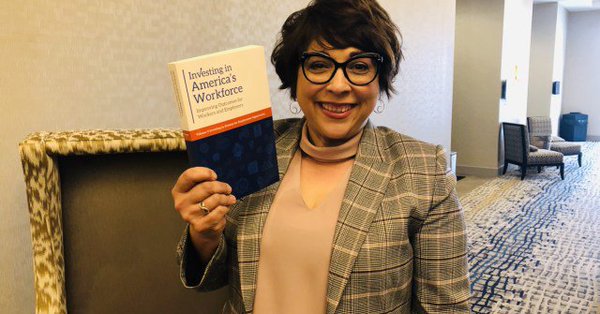
Share On Social!
The coronavirus (COVID-19) outbreak is surging across the U.S., and the American death toll has eclipsed 130,000.
Worse, this crisis is widening the gap experienced by households without internet access — a long-festering problem that has made unequal educational opportunities even more unbalanced, said Jordana Barton, a senior advisor in community development at the Federal Reserve Bank of Dallas.
“The COVID-19 pandemic has brought national attention to the digital divide—the gap experienced by households without internet access,” Barton wrote. “Directives for social distancing and stay-at-home orders have made access to broadband an urgent necessity for families as they struggle to stay connected with schooling, jobs, health care, government assistance, and more.”
The Digital Divide
More aspects of people’s everyday lives are moving online.
“Schools and colleges have shut down and moved to online learning platforms,” Barton writes. “Public health officials have called for medical clinics to use telemedicine in place of office visits. Remote work most often requires a broadband connection. But geographic and economic factors leave many families offline. In most urban areas in the U.S., for example, 30 percent of households earning less than $50,000 a year do not have a broadband internet subscription, according to the Census Bureau.”
According to the FCC’s 2016 Broadband Progress Report, 34 million Americans lack access to fixed broadband at speeds of at least 25 Mbps for downloads and 3 Mbps for uploads, and 39% of rural Americans (23 million people) lack access to 25 Mbps/3 Mbps.
 “This is a big problem of concern not just in the remote regions but also in big cities like Dallas and San Antonio,” Barton said.
“This is a big problem of concern not just in the remote regions but also in big cities like Dallas and San Antonio,” Barton said.
Barton also served as vice president for development and communications for the microenterprise/small-business organization Accion Texas.
“Access and skill in using the internet effectively have become essential for educational and economic opportunity, and broadband is now a basic infrastructure essential to the well-being of all communities,” Barton said.
The digital divide leads to further economic, social, and political disparities for low-income and underserved populations in the U.S. predominately in South Texas, Barton said.
Barton grew up in Benavides, Texas, near the Texas–Mexico border and understood public disparities in the region.
Connecting Communities During COVID-19 Pandemic
Owing to “COVID-19 City Response and Community Resiliency & Recovery,” on June 4, 2020:
“San Antonio’s City Council will consider a $191 million stimulus proposal and a little more than $27 million in the package will bridge San Antonio’s digital divide,” with the San Antonio Express-News writes. “The plan will attempt to close the homework gap by providing broadband access to low-income households by way of private wireless networks.”
According to the Federal Reserve report, one in four San Antonio households lack internet access.

Studies by Barton and others showed that 38% of San Antonians lack internet access, primarily on the city’s West and South Sides, and the package would call for sharing existing fiber infrastructure and provide at-home equipment to such households rather than short-term hot spots.
“The digital divide are more predominant in the border cities, making these communities less resilient during the pandemic. Closing the digital divide in low-income communities also brings economic opportunities,” Barton said.
Previously, the San Antonio Mayor Ron Nirenberg requested Barton to come up with a plan to reduce the digital divide in San Antonio and related areas.
The team posts an outline with some immediate actions that they can take to improve the availability and affordability of broadband in the area.
“This project will bring faster internet into student’s homes on a virtual network”, Ms. Barton said.
“Going forward, it should be clear that the lack of broadband access is a principal vulnerability. It inhibits the development of resilient cities and towns that are responsive to the public health, educational, and economic needs of all citizens, and much more work needs to be done,” Barton said.
Raise Awareness of Inequities During the Pandemic
Now the COVID-19 pandemic is worsening historical inequities and disproportionately affecting and killing Latinos and other people of color.
Check out these 19 solutions to immediately ease the coronavirus pandemic and its impact on Latinos and people of color, as well as make long-term strides to address underlying inequities that are aggravated during this time.
Also, get a “Health Equity Report Card” for your area! Select your county name and get a customized Health Equity Report Card by Salud America! At U.T. Health San Antonio and email your Health Equity Report Card to decision-makers, share it on social media, and use it to make a case for community change to boost health equity for the long-term.
Learn more about the coronavirus outbreak and its implications concerning Latino health.
Explore More:
EducationBy The Numbers
84
percent
of Latino parents support public funding for afterschool programs
This success story was produced by Salud America! with support from the Robert Wood Johnson Foundation.
The stories are intended for educational and informative purposes. References to specific policymakers, individuals, schools, policies, or companies have been included solely to advance these purposes and do not constitute an endorsement, sponsorship, or recommendation. Stories are based on and told by real community members and are the opinions and views of the individuals whose stories are told. Organization and activities described were not supported by Salud America! or the Robert Wood Johnson Foundation and do not necessarily represent the views of Salud America! or the Robert Wood Johnson Foundation.



